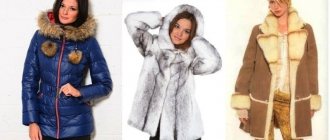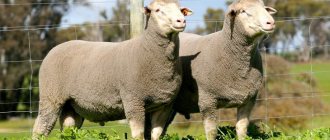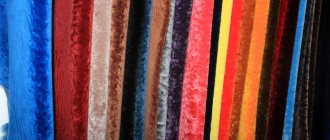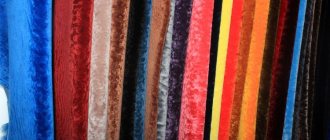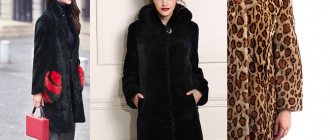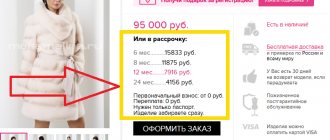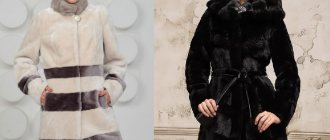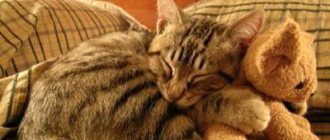In the 60s in the USSR, it was prestigious to have a fur coat made from a mouton or, as they used to say, from a tsigeika. This fur is still popular today. But from its name it’s difficult to understand from which animal’s wool fashionable outerwear is made. Not everyone knows that “mutons” are not some exotic animals that live in forests, but a domestic animal that is well known to everyone.
Based on the opinions of experts and studying reviews, we found out the main properties of a mouton, figured out how warm, beautiful fur coats are made from animal wool, how to choose a fur product from a mouton, how to care for it and what to wear it with.
What kind of fur is a mouton?
You may be disappointed, but the animal that produces this oddly named fur is the common domestic sheep. Warm socks, cozy sweaters, and mittens are knitted from its wool. And not only. Outerwear is made from dressed sheepskin - skin taken from adult animals or lambs older than six months.
Depending on the breed of sheep, its age, length, and quality of wool, sheepskin can be used for leather, fur, or fur coats.
Fur sheepskin is obtained from sheep that produce fine-fleece, semi-fine-fleece, and semi-coarse wool. Outerwear is sewn from it with the fur facing out.
From the skins of animals that produce heterogeneous coarse wool with a length of 1.5 cm, fur sheepskin is made. It is used to make sheepskin coats, sheepskin coats, fur vests, and sheepskin coats with wool inside. And the mezdra - the leather part of the sheepskin - is on the outside.
The fur of a sheepskin coat is soft, but quite durable, does not fall off or wrinkle, and is resistant to moisture. In the fur industry, the light, beautiful fleece of the Romanov breed of sheep with strong flesh is especially valued.
Sheepskin leather is skins with low quality hair that are not suitable for making fur coats and fur products. They are used in leather production.
And yet, why does fur have such a strange name? In Russian language dictionaries there is the following definition: mouton (translated from French mouton - sheepskin, valukh, ram) is a specially prepared valuable sheepskin with silky, shiny hair.
In Russia, mouton is the most common type of sheepskin. It is made from Australian merino skins. This breed of fine-wool sheep is bred in Australia and New Zealand. Subsequent processing of Australian mouton using formaldehyde, which is prohibited abroad, is carried out in Russia.
There are other types of sheepskin fur, which differ in the method of dressing the skin, in the type of fleece. Most often, confusion arises when it comes to tsigeika and mouton.
Mouton - whose wool is this?
The name mouton comes from French. Translated, the word means “ram” or “sheep.” This type of fur is obtained from sheep of a certain breed suitable for shearing. They are bred in New Zealand, Argentina and Austria. In Russia, Merino sheep are raised in the Caucasus to produce moutons.
The dressing technology makes it possible to obtain fur that imitates other, more expensive furs (mink, sable, etc.).
How does mouton differ from tsigeika and astragan
As we have already found out, a mouton is a processed, cut to a certain length, ennobled sheepskin of fine wool Australian merino with very thin and soft hair. After special dressing, the skin with a velvety glossy pile becomes lighter and more impressive. In some ways it is not even inferior to valuable breeds of fur.
Mouton can be cut or full (uncut). The length of the fibers of the latter is 1-1.2 cm. This is a very warm fur that will warm you up in 30-degree frost. The fibers of a cropped mouton are shorter - 0.6-0.8 cm. And the fur is less warm.
Tsigai fur products are made from sheared sheepskin of the Tsigai breed of animals. Initially, this was the name for refined goat fur (ziege - goat in German).
In the USSR, tsigeika was very popular. It was made using almost the same technology as the mouton: the fur was trimmed and dyed brown or some other dark color. But they didn’t treat it with formaldehyde. The pile turned out to be coarser, the products were heavier, not as strong and wear-resistant as those made from mouton.
Astragan fur is a type of mouton. It is produced using special technology using fine fur of the highest quality. Its peculiarity is twisted curls up to 7 mm long. Fur coats made from this material are lighter, more durable, and more expensive than mouton ones. It is recommended to wear them at temperatures down to -10 degrees.
To visually determine what kind of sheepskin a product is made from, you need to look at the height of the pile and its characteristics. For example, tsigeyka feels rough, heavy, and feels warm. Astragan with shorter hairs and pronounced curls is softer. Mouton products are characterized by smooth fur without curls. They are lighter than cigeaceae, but heavier than astragan.
What standards are used in production? What do they take into account?
Mouton is made using technology developed in Russia. The material is made on foreign equipment under strict control.
Technical requirements for the manufacture of sheepskin are specified in GOST 4661-76:
- Process the skins according to the configuration and straighten them evenly.
- Clean the leather fabric thoroughly and stretch evenly.
- Smooth the pile in one direction and work on its upper part. The pile should be shiny, cleaned, combed and crumbly.
- Sew up the tears while maintaining the symmetry of the skin.
- Straighten the seams carefully. Their height is no more than 2 mm.
How to make a mouton
The technological process consists of several steps. Animal skins removed in a single layer are cleaned, straightened, preserved, sorted, processed, dressed in a special way, and soaked in formaldehyde.
At the last stage, the skins are stretched, the edges are aligned, combed, the fur is carefully trimmed, and the pile is dyed in different colors: from white to charcoal black, brown. The result is durable, smooth fur with a plush dense texture that is resistant to friction, moisture, and mechanical stress.
According to one version, turning sheep skin into elegant thin fur was first possible in Germany, according to another - in France. Be that as it may, the new technology using formalin, which gave fur not only practicality, but also tenderness, very quickly spread everywhere. And it improved over time. They have learned to process sheep wool in such a way that it is difficult to distinguish it from elite fur.
Features of fur processing in production
Unprocessed animal skins are not very attractive; production features help them shine in all their beauty. The transformation process begins with dressing. At the raw material stage, the skins are selected and classified according to quality, size, and purpose. First, the skins are soaked and then undergo:
- fleshing;
- pickling;
- tanning;
- fatliquoring;
- drying
After drying, the skins are polished. At the next stage, the mouton is stretched, this action is performed in order to increase the area of the skin, so that in the future the products will have a minimum of seams. The fur is stretched on a special table. At the same time, the raw materials do not lose quality, remaining elastic and durable.
Then the hairs are treated with a formaldehyde solution. After this treatment, a mouton fur coat is not afraid of precipitation in the form of rain and wet snow. Treatment with chemicals is prohibited abroad; it is carried out exclusively in Russia. Subsequently, the fur undergoes special cleaning, making it absolutely safe for further use.
Then the mouton is colored, giving it any desired shade. At the final stage, the skin is transformed by smoothing it in a special way. After this, not everyone will be able to identify what it is made of. Now the semi-finished product is ready for sewing outerwear.
Description and characteristics
Fur processed using new technology with a high pile density looks flawless, does not wrinkle, and does not change direction. It is used to make practical, durable, weather-resistant sheepskin coats, mantles, fur coats, and fur coats that can last 5-8 seasons. And even more.
This is a light and warm material - in this parameter it is inferior only to beaver or sable. It is comfortable in both warm autumn and winter cold. Does not blow out in strong winds. The fur looks good even with everyday wear, does not pill, is moisture resistant due to the treatment of the fibers with a formaldehyde solution, and is well breathable. Wool dyes well - designers take advantage of this when coming up with models of different colors.
History of sheepskin from antiquity to modern times
Sheepskin fur has the most ancient and amazing history.
Starting from primitive man, the domestication of animals, the processing of animal skins for clothing and sleeping beds, the development of furrier craft to the present day. Since time immemorial, sheepskin fur has been valued as an unsurpassed universal material with many positive characteristics. Biblical heroes wrapped their children in sheep skins to keep them warm and dry. The inhabitants of Ancient Egypt were the first to develop a special technology for processing sheepskin; they knew a lot about luxury and had exquisite taste. And the inhabitants of Ancient Rome, addicted to a beautiful and comfortable life, borrowed from them the method of processing sheepskin.
The domestic sheep is an extremely timid, obedient and meek animal. Perhaps the sheep was one of the first domesticated animals. In the myths and legends of many peoples, herds and flocks of sheep are often mentioned, which accompanied people everywhere, providing sources of milk, meat, wool and sheep skins. Sheep skin was used by people to make clothes and shoes.
Since ancient times, rams, sheep and lambs have been sacrificed to various deities. Then people did not yet know about one God, but worshiped many deities. There was an opinion that there are heavenly and underground gods. A white sheep was sacrificed to the heavenly gods, and a black sheep was given to the gods of the dungeons. Ancient Greek legends say that Zeus's bed was covered with the skin of a white sheep.
In all the books of the Old Testament, sheep are mentioned much more often than other domestic animals. The image of a sheep is also present in many New Testament parables of Jesus Christ. You simply cannot find a more useful and convenient pet for humanity. These wonderful animals continue to benefit people to this day.
About 3 thousand years ago, northern peoples began to use sheep skins to make clothing. If before this period, skins were practically not tanned and were worn like capes with slits for the head, then from that moment on the era of using practical and comfortable clothing began. Sheepskin is a unique material that, thanks to its natural qualities - elasticity, softness, low thermal conductivity, has become an indispensable raw material for the manufacture of vests, capes, hats and shoes.
In the old days, hides were tanned “in a hurry”, without the use of tannins. The skins were salted and dried, and the clothes and shoes acquired the required softness during wear. Light leather shoes made of rawhide sheepskin without soles were worn by mountain residents in places with fairly dry summers.
In the Caucasus, Abkhazia and Georgia, Azerbaijan and Armenia, soft leather boots have been sewn from sheep skin since ancient times. These were “elite” boots for wealthy people close to princes. For these boots, the leather was specially tanned and the wool was removed from it. Such men's boots, almost unchanged, can be seen today in museums and among artists of modern folklore ensembles of the peoples of the Caucasus and Transcaucasia.
In Armenia and Georgia, peasants sewed vests and capes from solid sheepskin, with a slit for the head and without sleeves. Such clothes were worn with the fur facing out - the special fatty composition of sheepskin wool made it waterproof. Special sheepskin hats, tall and with long wool, are also popular there.
The harsh climatic conditions in our country make fur clothing and shoes a necessity. Since time immemorial, people in Rus' have worn clothes made from fur coats and sheepskins. Short fur coats, sheepskin coats, and warmer jackets were widespread everywhere due to their practicality and heat-protective properties. Therefore, a significant part of the population was engaged in the furrier craft of sewing sheepskin coats. By the beginning of the 20th century, 18 million people were employed in the clothing industry. Subsequently, the intensive development of light industry led to the construction of large factories. The trade turned into a working specialty for furriers.
There was a misconception that sheepskin products were purely plebeian clothing, which was intended only for “dark, illiterate and poor people.” On the part of the nobility, sheepskin products were subjected to contempt and ridicule, against the backdrop of luxurious fur stoles and floor-length coats made of expensive sable furs.
Before the revolution, people of royal blood willingly wore Russian short fur coats and sheepskin coats. In 1868, Grand Duke Vladimir Alexandrovich gladly accepted a gift from the hands of Altai merchants - a sheepskin sheepskin coat. And in 1870, Siberian sheepskin was highly appreciated by the commission for the organization of the All-Russian Exhibition and the Society for the Encouragement of Russian Industry and Trade.
Sheepskin fur has always been the most affordable type of fur for every peasant, because sheep were found in every yard and were not a curiosity. In Russian villages they sewed long tanned fur coats and jackets with fur inside - that is, sheepskin coats. A sheepskin coat is an ancient piece of peasant clothing, which is a wraparound fur coat worn with the sheepskin fur inside. The sheepskin coat received its name because of a special type of tanning - enhanced tanning gives the leather extra strength and one of the signs of quality is invariably the collar that stands up.
Starting from the 20s and ending with the 50s of the 20th century in the USSR, sheep skins, sheared on the one hand, and tanned on the other, were used in the production of military uniforms and uniforms. Sheepskin clothing was worn almost all year round. Depending on weather conditions, sheepskin can conduct or retain heat and repel or retain moisture. During two world wars, soldiers, pilots and sailors wore sheepskin clothing.
Sheepskin coats came into general European fashion after the Second World War. Sheepskin coats were worn by members of the legendary group “The Beatles” and the leader of the famous group “The Doors”, and after them - almost the entire generation of hippies of the 70s of the 20th century. In the wake of hippie fashion, Afghan embroidered sheepskin coats trimmed with Mongolian lama fur became popular. By the 80s, sheepskin coats had become common, comfortable and inexpensive clothing. In 1994, in connection with the return of 70s fashion, designers again paid attention to sheepskin. A hit was the golden sheepskin coat with white fur, which Janet Jackson wore in the Scream video.
What is sewn from mouton
Outerwear of any style and warm winter accessories, which are comfortable in cold winters, are made from refined fur fabric with a plush surface.
- These can be short jackets with or without a hood.
- Boleros are warm, beautiful mouton capes for cool autumn or spring weather that can be worn with different clothes.
- Short fur coats made of mouton - a shortened cut of a loose silhouette or a tight-fitting style with or without a hood, with long or short sleeves, in combination with fox, silver fox, and raccoon fur.
- A mouton coat is an elegant outerwear made of beautiful warm wool. The styles are varied: classic, fitted silhouette of moderate length, oversized, with or without a belt, with a hood, trimmed with the fur of other animals.
- Mouton vest - fur sleeveless vests in both short and long versions. Loose and tight. With the use of other decorative materials in finishing.
- A mouton sheepskin coat is a fashionable and popular women's outerwear.
- The prototype of a modern sheepskin coat is sheepskin coats, which were sewn from sheared sheepskin. In them, the fur, which serves as lining and insulation at the same time, remains on the inside.
- Fur coats of various styles and models: straight long, flared downwards, combining classic with fashionable details, hood and belt or without these details, collar and trim with mink, silver fox.
- Collars are sewn from fine-fleece and semi-fine-fleece sheepskin with fur on the outside; warm hats and berets are made from sheared sheepskin fur in combination with jacquard textiles and leather.
- A warm and beautiful accessory that complements the winter look is mouton mittens.
What purposes can this fabric be used for?
Used for sewing fur coats, sheepskin coats, as well as fur accessories and hats.
Things from mouton
How to choose a fur coat from a mouton
What do women pay attention to when choosing a fur coat? To make it warm, practical, light. But the main thing is fashionable, beautiful, stylish. If the initial purpose of the purchase is to stay warm in winter, a warm mouton coat is just what you need.
The wear resistance of the material is an important parameter if you are planning a purchase seriously and for a long time. A fur coat made from a mouton will last on average 5-10 years. How long depends on the quality of the fur, how it is processed, and how to care for it.
A high-quality fur coat should be light - many people pay attention to this. But this is a relative indicator: it depends on the type and quality of the skin, and on the length of the fur. For example, a polished sheepskin coat is always heavier than a mouton fur coat, and outerwear made from high-quality sheepskin is always heavier than items made from faux fur.
Fur quality
A very important parameter that determines how long the new thing will last. The fur should be dense, thick, smooth, shiny, soft, uniform without bald spots, bald spots, or paint stains.
It could use a little beating. The villi should not be pulled out. And especially to come out in large numbers. The fur should not be crushed and will immediately return to its original position if you run your hand over it against the pile. If something is wrong, the fur may be of poor quality. The thing will not last long and is unlikely to keep you warm in winter.
Tailoring quality
It is always necessary to check how well a fur coat is sewn, regardless of the popularity of a particular manufacturer. Pay attention to how tightly all parts of the fur coat are connected to each other, which should be sewn using the “skin to skin” method, and not glued.
The seams connecting the parts of the fur coat should be soft to the touch, elastic, flat, without moving edges or protruding threads, and can be easily felt even through the lining. If this is not the case, there is a risk of running into glued fur. After a couple of seasons, individual pieces of skin may fall apart at the seams.
The lining of a fur coat should be thin. The seams that connect it to the fur coat, to the hood, to the pockets are straight and neat.
Wanting to save money, some manufacturers use low-quality fur in lapels. This also needs to be checked. And also how and how securely buttons, hooks, decorative elements, and zippers are fastened.
Paint quality
All mouton fur coats are dyed in different colors. If everything is done according to technology using high-quality dyes, the fur remains elastic and shiny even after dyeing. Retains color for a long time and does not fade.
You can make sure that everything is in order here by running a piece of light cloth over the fur. If there are no traces left on it, good.
Style, length, color of fur coat
It is advisable to sort this out before purchasing. But if you follow the general recommendations, the length of the fur coat (unless it is a short fur coat or jacket) should correspond to height. As for the fur color and style, designers recommend choosing models closer to the classic ones, in a neutral color, for everyday wear. This makes it easier to combine outerwear with shoes and other things.
A few recommendations
The risk of counterfeiting a fur product on the market is much higher than in a specialized store. In the store, the buyer will be shown a product quality certificate confirming the safety of the product, which has passed all required tests. As well as a warranty card and all necessary documents that may be required in case of returning a fur coat.
The label on the lining of the product should contain information about the country of manufacture, the product itself, and recommendations on how to care for it.
What to look for when choosing a fur coat
Modern technologies make it possible to dye fur in various bright, spectacular and stylish colors, maintaining its shine and elasticity. Mouton fur coats are made in various styles and colors. The length of the fur coat should correspond to the height of its owner, and the color of the fur should be selected on the basis that the younger the girl, the lighter the mouton should be. If a fur coat is chosen for daily wear, then it is better to give preference to classic models and colors. This product can be combined with any clothing. In order not to make a mistake with your choice, you should pay attention to the quality of the fur.
- The fur should not be plucked, deformed or matted. To check this, it will be enough to take a piece of material with your fingertips and lightly pull it towards you.
- High-quality mouton fur coats are sewn so that the seams in them cannot be felt and are elastic. This gives the product a neat appearance.
The material allows you to create products with original, interesting details and complex cuts. At the same time, the fur will retain heat well. All these advantages make fur products in demand and popular.
How to distinguish a mouton from a fake and faux fur
Modern mouton fur coats are sewn and processed using modern equipment. They are very light - they weigh about two kilograms and do not look bulky. Based on these characteristics, they can easily be confused with artificial fur coats. But, unlike them, natural mouton retains its main qualities - wear resistance and the ability to warm in the cold. These are complete winter items.
Not a mouton fur coat at all, but something very similar to it, there may be Polish, Turkish, Chinese products that are sewn from cheap sheepskin, usually used for sheepskin coats. In such skins, first of all, the quality of the skin is valued, not the fur. But manufacturers pass them off as real mouton fur coats, turning the sheepskin over with the fur facing out.
They are dyed dark to hide the flaws of low-quality fur. Often, instead of fur dyes, dyes for suede and leather are used. After a couple of seasons, not a trace will remain of the beautiful rich color.
Such mouton-like fur coats made from ordinary sheepskin with thin flesh and sparse fur are of low quality. Products made from them, although natural, are not warm enough. More suitable for European winters with temperatures hovering around zero. Sometimes they are insulated with padding polyester. Insulated sheepskin is one of the signs that this fur coat is not made of mouton.
Compared to artificial fur coats, artificial fur is much longer. It must be secured to the base.
The shine of fur is another indicator: although artificial material shines, it does not look entirely natural.
Natural fur and products made from it are always heavier than those made from artificial material. Although modern mouton products, if you compare them with the heavy sheepskin coats from the times of the USSR, are also quite light.
How to check the quality of fur
A good quality mouton has a thick, even and shiny pile. It should not stain your hands when touched, wrinkle or leave creases when squeezed. The fur has a characteristic smell, and skin is visible on the back of the sheepskin.
Sheepskin products cannot be too light, and this must be taken into account when choosing. In high-quality fur, the lint does not come out when you try to pluck it.
Custom fur coats
Fashionistas of all ages often refuse heavy fur products. You can go anywhere in an elegant light fur coat: to work, for a walk. Everywhere it is comfortable, beautiful and warm. If we are talking about modern lightweight models made of mouton.
In order to preserve the main quality of a fur product at low weight - to keep you warm in winter, they are sewn from the skins of young animals. To do this, small skins are tanned and stretched. They become practically weightless. To make the item warmer, manufacturers sometimes use additional lining.
Lightweight fur coats weigh little, look good, are practical, and are inexpensive. The downside is that their service life is significantly shorter than that of their heavier weight counterparts.
Sometimes fur coats are made without skinning the animals. In this case, the wool is simply cut off. The resulting fur is processed and applied to a fabric base. To prevent the fur fabric from absorbing dirt and moisture, it is treated with special products. A product made from sheared wool is light, beautiful, and inexpensive. In the wake of humane treatment of animals, such clothing is in demand.
Of course, they are not as warm as natural sheepskin coats. Depending on the percentage of wool in the material, they can be worn at temperatures down to -10 degrees. Sometimes they use additional insulation.
Fur coats made from sheared wool are inferior to natural ones made from sheepskin in other respects: they do not absorb moisture well, are not as durable, become electrified, and synthetic materials in the composition can cause allergies.
Production
- The first stage of sheep skin processing is fleshing (cleaning the skins);
- Then, they are placed in a special drum, which rotates for several hours. Thus, the skins are given softness. After two stages of processing, such material is suitable for sewing ordinary sheepskin coats;
- The third stage is stretching the skin. At the same time, they do not lose their basic properties - strength and elasticity. On the other hand, the skins acquire a larger area, which makes it possible to use fewer seams when sewing products;
- The next stage of refining sheepskins is formaldehyde treatment. This method of processing sheepskin was invented to make the fur moisture resistant. In this case, the fur coats will not be afraid of rain, snow, or changes in temperature. I would like to immediately tell fashionistas that the use of formaldehyde when processing sheepskin is not dangerous to humans. Immediately after this treatment, the skins are cleaned of all chemicals;
- After this treatment, the skins are sent for painting. The fact is that natural color is not very attractive. Today, thanks to modern technologies, a mouton can be dyed in any rich color.
Also, with the help of new technologies, it is possible to make thick mouton fur light, which makes the product more comfortable.
Now production technologists cut the sheepskin and smooth the wool using a special method. After this, it acquires an unrecognizable chic look, the fur of which can only be recognized by specialists in the fur industry.
What to wear with a mouton fur coat
Nowadays they sew such fur coats from mouton that women wear them with pleasure with different clothes. Warm, light, flowing, of different styles, with mink and silver fox collars. The main rule is to put together a harmonious, stylish look in which things go well together.
Short jackets can be worn with jeans, trousers and even skirts. Short fur coats to the knee and slightly below go well with a skirt. But here you need to successfully choose the length and style of the latter. You can wear anything under a long fur coat.
Depending on the style and length of the product, appropriate shoes, suede or leather gloves, hats, the role of which can be played by a hood, and bags, are selected.
If you read what women write in reviews, the main idea can be formulated as follows: of course, you need to follow fashion. But a fur coat, first of all, should decorate a woman. And do not spoil its appearance in any way.
In general, owners of fur products made from mouton note the following qualities among the advantages:
- practicality - retains good appearance and shape even with constant wear in different weather conditions;
- fur coats are stylish, beautiful, fashionable - suitable for any age;
- very warm and light - they are comfortable in cold and windy weather;
- long service life - your favorite clothes will delight you for many years;
- affordable price.
There are practically no disadvantages if the fur coat has high-quality, correctly dyed fur and is professionally sewn in compliance with technology.
Pros and cons of fabric
Pros:
- The material is very warm and will keep you warm in severe frosts.
- The finished product is suitable for wear for up to 10 years, thanks to the dense structure of the hairs.
- Increased strength.
- Soft texture and shiny fur.
- Wear resistance. Mouton does not lose its appearance even with different types of processing.
- Affordable price compared to other types of fur.
Minuses:
- Fur is heavy due to the density of the material.
- The use of formaldehyde in dressing - due to its harm, mouton was no longer produced in Europe.
- Conservative clothing models. The style of fur coats has changed little since the 80s; it will be difficult to find a fashionable and original design.
- Requires careful care.
Recommendations for product care
In terms of durability, mouton fur coats are second only to otter fur. They can last up to six seasons. But this is only if the fur product is properly cared for, stored and protected. Care information is on the tag.
What not to do:
- the fur will dry out and quickly become bald if you constantly carry the bag on your shoulder;
- never dry a wet fur coat near heaters, radiators, do not use a hairdryer or iron - let it dry naturally in a cool, dry place;
- Do not spray antistatic agents, hairspray, perfume, or deodorant on the fur;
- You cannot store fur products in a plastic bag - only fabric covers can be used;
- You should not use narrow, flimsy hangers for off-season storage - only wide hangers that fit the size of the product and are designed for its weight;
- It is not recommended to air your fur coat in the summer on the balcony in the sun - only in the shade.
It is advisable that the closet where the fur coat hangs be spacious - otherwise the fur will wrinkle and become deformed. You need to dry clean your fur coat.
Practical sheepskin on fashion catwalks
In the Chanel collection, Karl Lagerfeld offered dresses made of the finest sheepskin. Alexander McQueen showed suits made of sheepskin in his collection, and the Emanuel Ungaro collection reflected the chic of the 70s in the finest sheepskin coats in all colors of the rainbow with raw edges. The Kenzo collection includes an ensemble made of tanned leather - a coat and a skirt with a blouse. In London, Tristan Webber, always careful with fur, presented bright coats made from small pieces of sheepskin in his autumn collection, and in Milan everyone remembered a gilded sheepskin coat from Iceberg and tanned handbags from Ruffo. Josefus Thimister, who created sheepskin clothing for Balenciaga, and Miuccia Prada, who featured dyed sheepskin with an incredibly soft pile in a dozen looks in the 2007 fall-winter collection for Prada, helped popularize this material.
The real excitement around sheepskin arose thanks to the efforts of Burberry creative director Christopher Bailey. For the first time in a long time, sheepskin clothing appears in the Burberry Prorsum collection in the fall of 2009: it is used in a gray sheepskin coat, which actress Keira Knightley will wear shortly after the show. After some time, Christopher Bailey presents the autumn pre-collection of Burberry Prorsum with men's and women's sheepskin jackets. But clothes made from sheepskin become real must-haves after the show of the Burberry Prorsum FW 2010 collection. The show opens with Carmen Pedara in a sheepskin bomber jacket, followed by Valeria Kelava, Frida Gustavsson, Shu Pei Kin and a dozen others in outerwear made of this material. models.
After the end of the shows for the autumn-winter 2010 season, it becomes obvious that sheepskin will become one of the main trends. Short jackets similar to pilot jackets appear in the collections of Phillip Lim, Adam, Giles, Just Cavalli and Rodarte. Sheepskin coats just above the knee are shown by Barbara Bui, Donna Karan, Hermes, Marc Jacobs and Rag & Bone. Acne and Celine make a voluminous coat from sheepskin, and Max Mara makes a floor-length sheepskin coat.
Designers have always needed sheepskin as a kind of auxiliary material. Sheep skin could be used to make a bag, boots or a hat. Paul & Joe line bags with sheepskin, Kenzo with ankle boots, Rodarte with collars, and Pringle of Scotland with shirts. Hussein Chalayan makes a case for binoculars from sheepskin. This trend was successfully copied by the mass market: Topshop jackets are reminiscent of Burberry Prorsum and Richard Krakoff, H&M coats hint at Etro, Uniqlo are similar to Adam and Roberto Cavalli, Oasis make vests from sheepskin fur, Bershka, Zara and New Look trim shoes and accessories.
Sheepskin instantly hits the blogs: Tommy Ton lists a vintage Balenciaga jacket among his favorite pieces of the season, Hanneli Mustaparta is seen in either a Maison Martin Margiela coat or a simple shearling jacket, and Wendy Lau prefers an H&M jacket. Models Lindsey Wixson, Abbey Lee and Anastasia Selezneva are not far behind them, rushing to castings in cardigans and coats decorated with sheep's wool. Paired with a floor-length knitted dress, a wide-brimmed hat and a hobo bag, short shearling coats embody bohemian chic.
